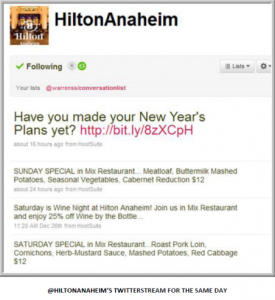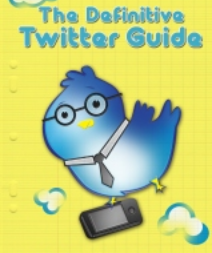You probably know I’m a big Shannon Evans fan. Her guest post, Local Search Secrets Exposed (also the name of her book) is one of our most commented-upon. (If you haven’t read it, bookmark it for later.)
So when I got an advanced copy of “The Definitive Twitter Guide: Making Tweets Work for your Business,” I was all over it. [Note: I was given a free book for this review.] It was an easy and informative read. The early chapters are geared more toward newbies but I picked up a few pointers I didn’t know. Chapters 10 to 14 gave me lots of ideas.
Yea or Nay?
Yea. This book can help businesses who consider themselves “Twitter savvy,” and is a must-read for Twitter newbies looking to expand their social media footprint.
Without giving away ALL her helpful tips, I’m compelled to share a few that spoke to me. And I include helpful tips and questions for your and Shannon’s perspectives.
Best comment in the book
Perhaps the biggest argument for implementing Twitter is it is permission-based marketing to begin with, you are attracting and not chasing clients.
I’d go further: Replace the words “for implementing Twitter” with “for pursuing social media for your business.” These followers *want* to connect with you, they are reaching out, starting the conversation. It should be relatively easy for you to continue it!
Shannon kindly features one of my experiences in Chapter 12. Talk about a lay up!
Shannon quotes me, “The marketing of defibrillators and ECG medical devices may not be a high profile group on Twitter. The lesson is regardless of your business focus, there will be people who are ‘into it.’ They will follow you if you are active and you engage with them.”
Worth repeating
- On defining social media: “Social media is about empowerment at the individual level. Participants can read or not read, follow or “unfollow,” join or leave. It is all about individual choice. Social media is the way people naturally share ideas, content, thoughts, and relationships online.
- “What’s In It For Me?”: No one really cares about your company name or your brand/logo, they care about what you or your brand does for them!
- On fear: Many companies avoid having any presence on social media sites because they fear that they will lose control of their message. They fail to realize they already HAVE lost control … people are talking about their brand whether or not they choose to listen and participate.
- On integrating online and offline marketing: Every box of cookies that Barbara Reininger, owner of www.MyKidsCookies.com, ships includes a business card that says “Follow me on Twitter.” Barb sends out tweets every few days about what‟s baking, specials, community activities on Bainbridge Island, and fun things about cookies.
- On tin-eared broadcasting: Don’t be like @HiltonAnaheim was. Answer your customers. Interact. Don’t broadcast. Twitter isn’t for that.
- On market insight: Twitter is a good place to post links to survey results and ultimately, guide followers to useful, pertinent information related to your goods, products, services, or niche.
- On press releases: Tweet your press release. You may reach an audience you’d otherwise miss.
- On landing pages: Important! If you tweet a special or promotion, Don’t link to your Homepage! Link to immediately relevant content.
Helpful Tips
- Don’t forget the power of a Twitter search (just like a Google one, but one on Twitter). You can interact with people talking right now about your brand or category.
-
Good one! I didn’t know this … Finding everyone in Seattle who has “marketing” in their bio: Go to Google advanced search; intext:”bio*marketing” intext:”location*Seattle”, then scroll to the bottom of the page and for the section “search within a site or domain”, add Twitter.com. (List-building tips on page 130.)
- Read pages 47-49 about keyword selection; 50-55 about Twitter backgrounds; 96 about directories to join.
- Excellent advice: If you are a dentist in Bellevue, WA why not snag the Twitter name “Bellevue Dentist.” Your profile will have your real name and URL, as well as a brief description that you provide, so there is nothing potentially stopping you from using the power of local search in your Twitter moniker.
- All of Chapter 10, “Manage and Measure with Third-Party Tools.”
And a few questions for you and Shannon
- Shannon, in Chapter 11, you say, “You can direct message them (DM) with specialized local messages to encourage more local Twitter account owners to follow you.” How can you do that? I thought you can only DM your followers. If so, how can you DM someone to follow you?
- I found this quote interesting, “Marketing Success is no longer measured by how far your reach is, but by how deep your network is … how deep is yours?” Shannon, maybe you’ll expound on this in the comments?
- Interesting perspective from @IASocialMedia‘s Mike O’Neil: “LinkedIn is a place for project updates and not status updates!” Not sure I agree completely. I think it’s ok to add a little color about yourself/interests. What do you think, readers?
- This next one is a point of discussion, company by company: “Social media has made it possible to put a face on a brand. No one wants to talk to a faceless entity. They want to talk to a real person and Twitter fortunately lets you put a name and a ‘voice’ to you and your brand.” In my experience, not every company is comfortable having a few prominent faces/spokespersons. What happens, after all, if that person leaves the organization? Your thoughts, readers?
Thanks for stopping by. If you found this review helpful or interesting, “Tweet,” “Like,” or join my growing readership.





Seems like a basic marketing starter with tips that cover general marketing principals. I also suggest “Twitter Marketing: An Hour a Day” by Hoillis Thomases
@Ted, when are you coming out with your book?! 🙂
@Ted, it is more than a basic marketing book. I conducted hours and hours of interviews and collected case studies of those out in the field using Twitter successfully and unsuccessfully. “Twitter an Hour a Day” is a terrific book but it is an ‘all things for all people’ book. The Definitive Twitter Guide is targeted toward the small business owner, consultant, or entrepreneur who is seeking highly targeted specific Twitter customer engagement techniques and tactics that they can apply quickly and inexpensively. Hollis’ book is similar in that she includes many of the same marketing and engagement techniques; however, where we differ is in the case study example model. But hopefully you will read my book and let me know what you think about the differences.
When does your book come out? Sounds really interesting! Now we need to get @Joehage to write a book.
I’ve pondered a book. Maybe one day.
Shannon, a few questions for you in the body of the article. Interested in your reply.